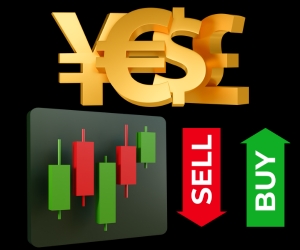CURRENCY SWAPS AND THEIR USE IN FOREX
Currency swaps are a cornerstone of modern financial markets, allowing two parties to exchange principal and interest payments in different currencies. Originally designed for large institutions and central banks, these instruments help manage funding, hedge risk, and support global trade. For traders, understanding how swaps function offers insight into liquidity flows and monetary policy decisions. In this article, we break down the mechanics of a currency swap, explore how institutions use them, and show practical examples that connect directly to Forex trading.

Swap Mechanics
At its core, a currency swap is a financial agreement between two counterparties to exchange principal and interest payments in different currencies. Unlike a simple spot trade, where one currency is exchanged for another at a single point in time, a swap involves both an initial exchange and a series of subsequent cash flows that unfold over months or even years. The goal is not speculation in most cases, but rather the management of funding, cash flow, or exposure in two different currencies.
The mechanics begin with the notional principal, the amount of currency that is being swapped. Party A delivers principal in one currency to Party B, while simultaneously receiving principal in another currency. For example, a European bank may swap €100 million with an American bank in return for the equivalent in U.S. dollars. The exchange rate applied at inception determines the initial notional amounts. Unlike a spot transaction, however, both sides agree that at the end of the contract the principal will be exchanged back at the same rate, providing certainty for both counterparties.
Fixed vs Floating Interest Payments
What distinguishes a swap from a simple loan is the ongoing exchange of interest payments. Each party agrees to pay interest on the notional principal it has received, typically tied to local benchmarks. For instance, the European bank receiving dollars may agree to pay U.S. dollar interest based on SOFR (Secured Overnight Financing Rate), while the American bank receiving euros pays interest linked to EURIBOR. The structure can involve fixed rates, floating rates, or a combination, depending on the objectives of the counterparties.
This ongoing interest exchange transforms a swap into a flexible funding tool. A firm that finds borrowing expensive in its home market can effectively tap into cheaper foreign funding through a swap, while its counterparty achieves the opposite benefit. This is why many multinational corporations and banks rely heavily on swaps to smooth their cost of capital across jurisdictions.
Tenors and Customisation
Currency swaps are not one-size-fits-all. Tenors range from short-term agreements lasting a few months to long-term arrangements stretching 10 years or more. The terms are customised to fit the needs of the counterparties, including the notional size, the currencies involved, the interest rate structure, and the schedule of payments. This flexibility makes swaps a powerful alternative to issuing bonds or borrowing directly in foreign markets, particularly when conditions in one market are temporarily unfavourable.
The flexibility does not end there. Some swaps allow interest payments to be netted, meaning only the difference between the two legs is paid. Others require gross payments, with each side delivering its agreed amount in full. These details can significantly affect cash flow planning and risk management, so counterparties typically negotiate carefully before entering into an agreement.
Collateral and Counterparty Risk
Like all derivatives, currency swaps involve counterparty risk: the possibility that one side may default on its obligations. To mitigate this, swaps are often collateralised, especially when arranged between banks or through central clearinghouses. Collateral can take the form of cash or high-quality securities, adjusted periodically to reflect changes in market value. This system reduces credit exposure but also introduces operational demands, as collateral must be managed and adjusted in real time.
For central banks, which are among the largest users of swaps, counterparty risk is less about financial default and more about policy coordination. During crises, such as the 2008 financial meltdown or the COVID-19 shock in 2020, central banks established swap lines to ensure dollar liquidity abroad. These arrangements worked smoothly because they were backed by sovereign guarantees rather than private credit.
Accounting Treatment and Balance Sheet Impact
From an accounting perspective, swaps are off-balance-sheet items in many cases, but they still influence reported risk and funding costs. The initial exchange of principal affects liquidity ratios, while the ongoing interest payments alter income streams. Companies must carefully manage how these flows interact with their broader financial statements. Regulators, aware of the systemic role swaps play, require detailed disclosures to ensure transparency and to monitor systemic risk.
Comparison to Forwards and Futures
It is useful to distinguish swaps from forwards and futures, which are also common in the Forex market. A forward contract fixes an exchange rate for a single transaction in the future, while a futures contract standardises this process on an exchange. A swap, by contrast, involves not only an initial and final exchange of principal but also recurring cash flows tied to interest rates. This makes swaps more complex but also more versatile, serving as both a funding tool and a hedge against interest rate and currency risk simultaneously.
Practical Example
Consider a Japanese company with substantial operations in the United States. It may prefer to borrow in yen at home, where it enjoys a lower rate, but it also needs dollars to fund its U.S. expansion. By entering into a currency swap with an American bank, the Japanese company can exchange yen for dollars upfront and agree to pay interest in dollars over the life of the swap. At the end of the contract, it will return the dollars and reclaim its yen, having effectively secured dollar financing at a competitive rate. The American bank, meanwhile, gains access to yen funding, which may be scarce in its own market.
This simple structure illustrates the elegance of swaps: each side gains what it could not as easily achieve in its domestic market, while global capital flows more smoothly across borders.
Institutional Uses
Although retail traders rarely encounter currency swaps directly, these instruments sit at the very core of institutional finance. Banks, corporations, and central banks rely on them to manage risk, fund operations, and stabilise economies. By understanding how large players employ swaps, traders gain valuable insight into the flows that shape the broader currency market.
Banks and Financial Institutions
Commercial and investment banks are the most active users of currency swaps. They employ these agreements to fund themselves in foreign currencies without tapping volatile spot markets or issuing costly debt. For instance, a European bank that needs dollars to fund its U.S. operations might arrange a swap with an American bank that needs euros. Each institution gains access to cheaper and more stable funding in the required currency, while avoiding exchange rate uncertainty.
Beyond funding, banks also use swaps to create products for clients. Corporate treasurers, hedge funds, and sovereign wealth funds often approach banks for tailored swap arrangements that align with their specific needs. In this way, banks serve both as principal users and as intermediaries, generating revenue while facilitating global capital flows.
Corporations and Multinationals
Global companies frequently face the challenge of mismatched revenue and expenses across currencies. A Japanese car manufacturer may earn most of its revenues in dollars from U.S. sales, but pay wages and suppliers in yen. By entering into a currency swap, the firm can better align its cash flows. It receives dollars to match its U.S. income and pays interest in yen, ensuring that financing costs mirror the currency of its obligations. This reduces earnings volatility and provides predictability for shareholders.
Corporations also use swaps to tap foreign markets for cheaper funding. A firm may discover that issuing bonds in a foreign currency is more cost-effective than raising capital at home. Through a swap, it can convert the proceeds into its domestic currency while continuing to service the bond in the foreign one. This strategy is common in industries with high capital requirements, such as energy, aviation, and infrastructure.
Central Banks and Sovereign Use
Central banks use swaps for a different, but equally critical purpose: stabilising financial systems during times of stress. When global demand for dollars spikes, as happened during the 2008 financial crisis and again in the early months of the COVID-19 pandemic, dollar shortages can cripple international markets. To address this, the U.S. Federal Reserve establishes swap lines with other central banks. These agreements allow foreign central banks to access dollars, which they can then lend to domestic banks. In return, the Fed receives the foreign currency, with both sides agreeing to reverse the swap later.
Swap lines are not simply technical tools; they are signals of global policy coordination. When traders see them activated, they interpret it as a commitment to maintaining liquidity and stability. This often calms markets and restores confidence, even before the funds are widely deployed. The sight of central banks leaning on swaps underscores their importance as instruments of monetary diplomacy.
Hedge Funds and Asset Managers
Although less frequent than banks or corporations, hedge funds and asset managers sometimes use swaps to express views on interest rate differentials. A fund expecting euro rates to stay lower than U.S. rates might enter a swap that pays euro interest and receives dollar interest. This positions the fund to benefit if the differential widens, while also gaining access to leveraged exposure without transacting directly in spot markets. Such strategies can amplify returns but also increase risks if rates move against them.
Case Study: The Eurozone Debt Crisis
During the Eurozone debt crisis of 2010–2012, European banks faced severe challenges funding themselves in dollars. Many held U.S. mortgage-backed securities and other dollar-denominated assets, but their access to dollar funding markets dried up as confidence eroded. The Federal Reserve responded by opening and expanding swap lines with the European Central Bank, ensuring that euro-area institutions could secure the dollars they needed. Without these arrangements, funding shortages might have spiralled into systemic collapse. The episode demonstrated how swaps are not just financial tools but also pillars of global financial stability.
Why Institutions Prefer Swaps
For institutions, swaps often present advantages over alternatives such as issuing foreign bonds or transacting repeatedly in the spot market. They provide certainty, customisation, and efficiency. Costs are generally lower, and terms can be tailored to align with cash flow needs. More importantly, swaps lock in funding without the risk of sudden currency swings, allowing institutions to plan with greater confidence. This reliability is why swaps, though largely invisible to the retail trader, underpin much of the international financial architecture.
FX Trading Examples
While currency swaps are primarily the domain of banks, corporations, and central banks, their impact filters down into the daily dynamics of the Forex market. For traders, observing how and when swaps are used can provide valuable context for currency flows, yield differentials, and volatility. By studying real-world examples, it becomes easier to see how these instruments influence price action and where opportunities emerge.
Carry Trade Support
One of the most relevant connections between swaps and Forex trading is their role in sustaining carry trades. A carry trade involves borrowing in a low-yielding currency and investing in a higher-yielding one, profiting from the interest rate spread. Swaps help institutions fund these strategies efficiently, ensuring that liquidity is available in both currencies involved. For example, a Japanese bank borrowing yen to invest in Australian bonds may enter a swap to secure Australian dollars, which then feeds directly into the AUD/JPY market. Traders monitoring this pair can often detect the influence of large institutional swap flows in its trend behaviour.
Central Bank Liquidity Lines
Swap lines between central banks are among the most significant drivers of Forex sentiment in times of crisis. During the COVID-19 pandemic, the Federal Reserve reactivated extensive swap arrangements with global central banks, providing hundreds of billions of dollars in liquidity. This action directly stabilised dollar pairs, calming volatility and restoring order to markets. For traders, announcements of swap lines are signals that funding stress may ease, which in turn shapes expectations for major dollar crosses such as EUR/USD, GBP/USD, and USD/JPY.
Corporate Hedging and Market Impact
Corporate use of swaps can also ripple into Forex trading. Imagine a multinational energy firm issuing debt in euros but earning revenues in dollars from oil sales. By entering into a swap, it converts its euro debt service into dollars. Large flows of this type can influence EUR/USD, especially if replicated by multiple corporations at once. For discretionary traders, identifying periods when corporate hedging demand is concentrated can help explain otherwise puzzling price moves and create alignment with underlying flows.
Speculative Uses of Swaps
Although swaps are not generally accessible to retail traders, hedge funds and sophisticated institutions sometimes use them speculatively. For example, a fund that expects U.S. rates to rise faster than European rates may structure a swap that pays euro interest and receives dollar interest. If their view proves correct, the differential widens, and the trade generates profit. Such positions can indirectly influence Forex markets by amplifying demand for one currency over another. Observant traders might notice these pressures in swap-driven moves in pairs like EUR/USD.
Case Study: Emerging Market Stress
Emerging markets provide some of the clearest examples of how currency swaps affect Forex prices. When Turkey faced sharp lira depreciation in 2018, local banks scrambled for dollar funding. Swap markets became strained, with offshore rates spiking dramatically. This squeeze forced many traders to reduce lira short positions, causing sudden reversals in USD/TRY. The episode highlighted how swap mechanics, usually invisible, can directly dictate market direction when liquidity dries up.
Similarly, during periods of stress in Asian markets, cross-currency swaps involving the Korean won or Indian rupee can drive rapid changes in forward points and spot levels. Traders watching these currencies closely know that swap spreads often act as leading indicators of stress, signalling when spot market moves may accelerate.
Reading Swap Signals in FX
For Forex traders, swaps may appear abstract, but the signals they generate are highly practical. When cross-currency swap spreads widen, it often means funding stress is building, which can weaken a currency even if fundamentals remain unchanged. Conversely, narrowing spreads usually signal easing conditions, offering traders confidence to hold positions. By adding swap market indicators to their toolkit, traders can anticipate shifts in currency demand before they fully appear in spot markets.
Why FX Traders Should Care
Ultimately, currency swaps underpin liquidity, interest differentials, and funding—the pillars of the Forex market. Even though individual traders rarely transact in swaps, understanding their role helps explain movements that may otherwise seem mysterious. From carry trades to crisis interventions, swaps shape the flows that drive exchange rates. Recognising this link equips traders with a broader perspective, allowing them to read between the lines of central bank policies, corporate hedging, and institutional positioning.








